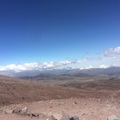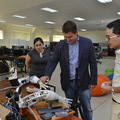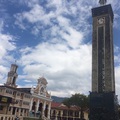28-29.07.2015.
San Pedro de Atacama
After a 16 hour bus ride from La Serena, I arrived to San Pedro. First I visited the museum of the Archeological Faculty of the University of La Serena and the memorial of father le Paige, a Jesuit missionary, who worked in the region from the 1950's until his death in 1980. He was the one who "rediscovered" the beauties of the region, (re)named and published them to the world. Thanks to him now everyone knows the town of San Pedro with 10.000 inhabitants, 20.000 tourists (yearly) and 30.000 wild-living dogs. (In my view this is a serious problem in the whole country.)
In the afternoon I took a tour to the Moon Valley and to the Death Valley. The Moon Valley was named after its white, salty and rocky surface. However for the origin of the name of the Death Valley, there are several legends. One is when father le Paige heard the name of the Valley, called Martian Valley (Valle de Marte) - named after its red rocky surface - misunderstood it for Death Valley (Valle de Muerte), and put this name to his books. The other theory is that there is no life in the valley because of the lack of water, which was scientifically proved afterwards. (Of course with the exceptions of tribes of tourists.) Both places were breathtaking.
The night went by without anything special, not counting the cold. In cheep hostels, where I stay usually as well, there is no heating. I was prepared with sleeping-sack in my back, which in the first time of my journey had to use (under the blankets). In the morning I saw that every drop of water is frozen on the streets. Later on, a guide said, that we passed the night with -15 degree Celsius...
My start in the morning was planed for 8 o'clock. However after 8.30 I started to loose my patience, which a lot of Latin-American experts suggested with whom I spoke before my trip. I called the agency for information. I was afraid that they forgot me... After several calls (and a lot of roaming cost) they informed me that the minibus had a punch and they will catch me soon. Finally at 9 we started the tour. The delay was compensated by the petroglyphs and wall paintings in the rocks of Yerbas Buenas. These can be dated between 10.000-800 b.C. There are drawings of lamas, shamans, monkeys and see-animals. These are the proofs, that Amazonian people where crossing this site, which served as a meeting point with water for tribes in a dry region. Then we went to the Rainbow Valley, which was named after the colourful stonewalls and rocks in a valley made by a river hundreds of thousands of years ago. The colours of the rocks are coming from rare metals driven from the bottom of the earth by volcanic activity, and these painted the stones red and green from the inside out. It was simply astonishing.
My program in the afternoon included a "just in time" arrival, which rarely functions in Latin American countries. The tour was said to finish at 7.30 pm and I had my bus to Arica at 8.00 pm. But the owner of the agency promised that I will arrive in the bus station no later then 7.45. Due to pressure of time and the amount of things have to be seen, I decided to take my chance. We went to the Lagunas Cejar and the Lagunas of Piedras, which are as salty lakes as eg. the Dead See. The water was about 14-15 degree Celsius (due to the cold at night). Inside, there were some warm streams probably because of volcanic activity. It was very cold but it was fun. However I was near to a heart attack on the way back, we arrived at 7.58 at the bus station. Finally we managed.
Although the night was long. Instead of the original bus company, an other bus waited for the passengers in the terminal of San Pedro, they said we had to change bus in the next big city called Calama. We were waiting one hour on the street for the bus of the original company. But it finally arrived with enough seats on it for everyone. It turned out that the mining workers in Chile went on strike two days ago, and last night there were fightings between the police and them. The "result" was that two miners died in the clashes. As a response they cut the main highways and motorways of the country. This meant that the bus had to use lower grade streets to able to get to the destination. After 15 minutes of starting our journey to Arica, the driver announced that we have a punch and have to turn back and change the bus... So again back to Calama to the bus station, changing the bus and now the 10 hour drive turned to be a 16 hour ride.



